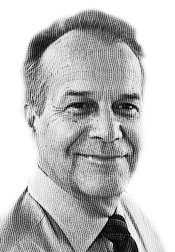Past, Present and Future of CPAP

M.B.B.S., Ph.D, FRACP
Colin Sullivan, M.B.B.S., Ph.D, FRACP – the inventor of continuous positive airway pressure (CPAP) – received the Sleep Innovator Award at the National Sleep Foundation’s Annual Awards Dinner during National Sleep Awareness Week® 2009. We asked Professor Sullivan to share his thoughts about the past and future of CPAP.
What were some of your pivotal moments in the laboratory, and how have these discoveries changed the treatment of sleep apnea?
The pivotal moment was a night in June 1980 when we first tested the idea that positive pressure, applied just through the nasal airway, could stop obstructive apnea. Although I had the idea several months previously, at that time we saw only very few patients, so we had to wait for an appropriate patient to do the experiments. The patient in whom the first test was done had very severe sleep apnea and had come under my care at the Royal Prince Alfred Hospital where I was a physician in the Respiratory Unit. He was so severe that I had recommended a tracheotomy as an urgent procedure. However, he and his family refused surgery, but he was happy to volunteer for the pressure experiment. We put together the breathing circuit in the afternoon, and then used plastic tubes and a rapid setting silicone sealant to provide access to the nasal airway. Within minutes of the full polysomnography (PSG) set-up, the patient had gone to sleep and developed repetitive severe sleep apnea. I gradually increased the air pressure in the circuit, and then suddenly the apnea stopped and normal breathing appeared. It was an incredible result. As we watched in amazement, the patient went into REM sleep. I quickly decided to repeat the experiment by dropping the pressure and the apnea recurred. I went through a series of cycles increasing the pressure and so literally “turning off” the apnea, and then dropping the pressure and “turning on” the apnea. There was no uncertainty or ambiguity. The method worked. The effect was so clear and repeatable, the next question to answer was would it work all night? Could we use it as a treatment? We decided to leave the patient on the pressure for the rest of the night. We watched as he continued to sleep for around 7 hours, without any apnea, and with the most extraordinarily intense sleep patterns. The patient’s response the next day was equally exciting. He was awake and alert for the first time in years.
There have been many pivotal moments since, but this was the start of the nasal CPAP era. Over the next several years we did many experiments in which we used the method to demonstrate and dissect the many adverse outcomes that sleep apnea causes. Although everyone knows that nasal CPAP is a great treatment, not many realize that it continues to be an extraordinary, elegant, experimental method. The experiment that we did on that first night in June 1980 has been, and is being used, by numerous research groups to unravel the mechanisms by which sleep apnea causes so many medical problems. There are few other diseases where the underlying key event (upper airway obstruction, in the case of sleep apnea) can be turned off and on at will. What this means is that measurements can be made (for example of blood vessel function, hormonal levels, or cellular function) before and after treatment in the same subjects, so that the precise effects of sleep apnea can be revealed. A large number of experimental studies using this method have now shown that sleep apnea activates the cellular pathways that cause atherosclerosis, hypertension, and many other pathological processes. These ongoing studies are truly remarkable.
Another pivotal moment for us is when we first tested nasal ventilation during sleep using the CPAP circuit and found that we could effectively manage patients with chronic respiratory failure using this system. Non-invasive ventilation is now used as the front line treatment for many patients with respiratory failure.
What do you see as the key development in the commercialization of CPAP?
We made and provided the masks and CPAP systems in our workshop so that by 1985 we had over 100 patients on long-term home therapy. The commercial availability of a suitable system from Respironics in the United States was in 1985. This allowed many groups to begin using nasal CPAP and undoubtedly had a major impact in the development of sleep clinics and laboratories. A second key advance was the invention of the self-sealing mask (the “bubble mask”) in 1990 that greatly enhances a patient’s comfort and use. There have been many other developments including the introduction of BiLevel CPAP, autosetting CPAP systems and numerous nasal pillows that have greatly added to the area.
Are you surprised with the advancement of CPAP treatment today?
Nasal CPAP use is now so common that I have to make myself go back to the beginning to answer this question. At the time of the first experiment, nasal CPAP as a treatment looked like a useful rescue therapy to give us time to find a surgical cure. So, yes I must say that I am indeed surprised that nasal CPAP is now the front-line therapy for sleep apnea. I recall that in the early days,patients would use the treatment as it had such a dramatic effect on their daytime function – their personal feedback was the key to CPAP’s continuing acceptance. We now know sleep apnea can cause all of the common vascular diseases, so we are asking people with less severe symptoms to use CPAP to prevent having a heart attack or stroke. However, the comfort of the systems has improved. I often ask my patients to think of CPAP like reading glasses. They are a nuisance but you can’t do without them. Unlike other therapies, they don’t have to worry about drug side effects.
Where do you see obstructive sleep apnea treatment in 20 years?
I think we will be more effective at prevention. Many of us think that children who snore are the group in whom adult sleep apnea will develop, and that appropriate orthodontic treatment to promote the growth of a larger upper airway will play an important role in prevention. However, I am sure that nasal CPAP will remain a front-line therapy. The search for a magic pill will go on, but they are still not yet on the horizon.
What is the current focus of your research for the treatment of sleep apnea?
I have several areas of active research. The first is in infant and childhood obstructed breathing. This area has been neglected compared to adult sleep medicine, yet sleep disordered breathing in childhood is probably very instrumental in delaying or damaging cognitive development. We have a number of projects designed to better identify these children at risk. The second area is sleep disordered breathing in pregnancy. We showed several years ago that women with pre-eclampsia develop obstructed breathing in the third trimester and that it triggers a large rise in arterial blood pressure in sleep. Nasal CPAP stops the obstruction and prevents the blood pressure rise. We have an on-going multi-center study to determine how many women snore in pregnancy and to determine if the onset of snoring in pregnancy induces hypertension and gestational diabetes. I am developing new methods of recording sleep disordered breathing that are more suitable for children and can be used both long term and in the subject’s own home.
Do you see any recent United States public policy/private payer decisions as having a particularly motivating or chilling effect on CPAP use?
I understand that reimbursement remains an issue. I am concerned that there is lack of services for children with sleep
disordered breathing, and I suspect that there are many children who have significant disease that goes untreated. I also know there is controversy over how and who should do sleep apnea studies. Many professionals object to the use of ambulatory at-home testing. While I share the concerns that patients might be treated without adequate medical evaluation, I do think simplified diagnostic methods do allow better access to diagnosis. I think the problem here is that the sleep centers should be taking the initiative and developing practice protocols that utilize these methods so they are better able to triage patients and identify the problem patients who need more complex investigation.
What can be done to improve compliance with CPAP treatment?
Compliance rates of CPAP use in general are remarkably good and match the compliance rates for medications for chronic conditions. In an interesting way, the use of compliance monitoring on CPAP systems has given the clinician a very effective tool that is not available, for example for use of antihypertensive drugs. However, there is robust evidence that the best compliance only occurs if the introduction of the patient to CPAP is done with well trained experts, and if the patient is closely followed and supported by those people. Within the noise around the various debates on ambulatory at-home versus full in laboratory PSG, this point is often missed. What matters is that experienced people manage the patient at the beginning, and then compliance can be excellent.
There is little point in having some untrained franchise doing a portable diagnostic study and simply putting someone on CPAP using some simple protocol. Unless those people know what they are doing and support and care for the patient in the first few months, long-term compliance will be poor.
The right head support can greatly improve how comfortable you feel in bed.Learn more about how these medical devices can make a big difference in nighttime comfort for people with breathing issues.Sleep Apnea is a sleep disorder in which breathing is briefly and repeatedly interrupted during sleep. Learn how to cope...A frequent need to get up and go to the bathroom to urinate at night is called nocturia. It differs...Nearly one-quarter of all workers have shifts that are not during the daytime, and more than two-thirds of these workers...The Electronics and Sleep infographic highlights how technology affects the modern family and how parents can help design a sleep...Orexin receptor antagonists: A new class of sleeping pill Find out more about orexin, and a new type of sleep...You don't have to struggle with sleepless nights. Help is available! There are treatment options for insomnia, ranging from behavioral...Great news: more than three-fourths (76%) of those surveyed say that they had a good night’s sleep at least a...How you feel about the sleep you get every night is known as sleep satisfaction. Unlike sleep quantity (which objectively...

Source: Internet
